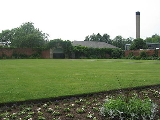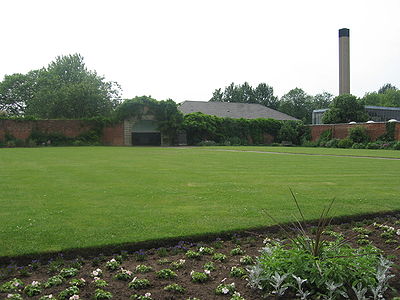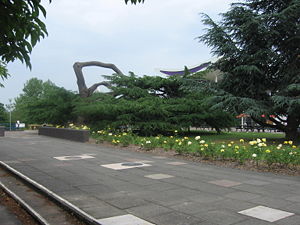
Burleigh Hall
Encyclopedia
Burleigh Hall was a country house
situated near Loughborough
in the county of Leicestershire
. Its land now forms part of the campus of Loughborough University
.

, Parliamentary forces
chased Royalists
back to their garrison at Burleigh House at which time it was in the possession of the Hastings family. Following these events it was the third William Jesson (1650–1711), grandson of William Jesson
(1580–1651) the Coventry
dyer, Mayor and MP
, who established a family seat at Burleigh Hall. He married Penelope Villiers of the influential Villiers family of Brooksby
on 23 January 1669, he having been knighted the previous year.
However this was short-lived as in 1700 the estate was taken over by the Tate
family, in 1711 it was held by Henry Tate and stayed directly in the family until the death of George Tate on 18 April 1822. George Tate appears to have died with no close relatives, the following is an extract from Bulletins and Other State Intelligence for the year 1849:
Miss Louisa Pinfold Tate died on 21 July at her residence in Wimpole Street
, Marylebone
, London
, her death being reported in The Gentleman's Magazine July–December, 1861 The next reference to the Hall's ownership comes in 1847 when there is again an end to the lineage of the owning family, Miss Julia Tate is described as being wealthy and without a known living relative, with the author of an 1847 Tourist Guide describing how Miss Tate ...is not only a musician, but a linguist; has travelled on the continent, and was desirous of visiting the United States, and seeing a country of which she has read, and heard so much, both for and against.
In 1958 the then owner of the Burleigh Estate agreed to sell the whole of his land to Loughborough College of Technology
, at which time it was around 90 acres (364,217.4 m²), this included Burleigh Hall which the College had intended to use as its administrative centre but its fabric had deteriorated to such an extent that it was decided that demolition was the best option.
. At this time the hall was owned by Miss Julia Tate who John Sherburne described as having selected a collection of paintings with much taste and placed her mark upon the property with it showing the handiwork and judicious mind of woman.
The Hall was probably constructed in the second half of the seventeenth century, likely to be linked to the arrival of the Jesson family. Given a Georgian
appearance around a century later, it was described as having an ornate pediment
ed facade
faced eastwards towards the town, and [a] plainer one, westwards towards Charnwood Forest
at the time of its demolition.
Having been an estate of around 374 acres (1.5 km²) in 1831 it had fallen to around 90 acres (364,217.4 m²) in 1958 when it was sold to the College, being then added to the Campus forming the area west of the existing playing field site.
 Following the demolition of the main house there are a few remnants of the estate which can be seen around the University campus today:
Following the demolition of the main house there are a few remnants of the estate which can be seen around the University campus today:
English country house
The English country house is a large house or mansion in the English countryside. Such houses were often owned by individuals who also owned a London house. This allowed to them to spend time in the country and in the city—hence, for these people, the term distinguished between town and country...
situated near Loughborough
Loughborough
Loughborough is a town within the Charnwood borough of Leicestershire, England. It is the seat of Charnwood Borough Council and is home to Loughborough University...
in the county of Leicestershire
Leicestershire
Leicestershire is a landlocked county in the English Midlands. It takes its name from the heavily populated City of Leicester, traditionally its administrative centre, although the City of Leicester unitary authority is today administered separately from the rest of Leicestershire...
. Its land now forms part of the campus of Loughborough University
Loughborough University
Loughborough University is a research based campus university located in the market town of Loughborough, Leicestershire, in the East Midlands of England...
.

History
An early reference to the Burleigh estate describes how during the March 1644 Battle of Cotes Bridge in the Civil WarEnglish Civil War
The English Civil War was a series of armed conflicts and political machinations between Parliamentarians and Royalists...
, Parliamentary forces
Roundhead
"Roundhead" was the nickname given to the supporters of the Parliament during the English Civil War. Also known as Parliamentarians, they fought against King Charles I and his supporters, the Cavaliers , who claimed absolute power and the divine right of kings...
chased Royalists
Cavalier
Cavalier was the name used by Parliamentarians for a Royalist supporter of King Charles I and son Charles II during the English Civil War, the Interregnum, and the Restoration...
back to their garrison at Burleigh House at which time it was in the possession of the Hastings family. Following these events it was the third William Jesson (1650–1711), grandson of William Jesson
William Jesson
William Jesson was an English dyer and politician who was active in local government in Coventry and sat in the House of Commons between 1640 and 1648....
(1580–1651) the Coventry
Coventry
Coventry is a city and metropolitan borough in the county of West Midlands in England. Coventry is the 9th largest city in England and the 11th largest in the United Kingdom. It is also the second largest city in the English Midlands, after Birmingham, with a population of 300,848, although...
dyer, Mayor and MP
Member of Parliament
A Member of Parliament is a representative of the voters to a :parliament. In many countries with bicameral parliaments, the term applies specifically to members of the lower house, as upper houses often have a different title, such as senate, and thus also have different titles for its members,...
, who established a family seat at Burleigh Hall. He married Penelope Villiers of the influential Villiers family of Brooksby
Brooksby
Brooksby is a village in Leicestershire, England. Brooksby Melton College offers apprenticeships and further education training courses in animal care, countryside, equine, fisheries, and land based service engineering....
on 23 January 1669, he having been knighted the previous year.
However this was short-lived as in 1700 the estate was taken over by the Tate
Tate
-Places:*Tate, Georgia, a town in the United States*Tate County, Mississippi, a county in the United States*Táté, the Hungarian name for Totoi village, Sântimbru Commune, Alba County, Romania*Tate, Filipino word for States...
family, in 1711 it was held by Henry Tate and stayed directly in the family until the death of George Tate on 18 April 1822. George Tate appears to have died with no close relatives, the following is an extract from Bulletins and Other State Intelligence for the year 1849:
Whitehall, July 17, 1849
The Queen as been pleased to grant unto Louisa Pinfold, of Wimpole-street, in the parish of Saint Mary-le-bone, in the county of Middlesex, and of Burleigh-hall, in the parish of Loughborough, in the county of Leicester, Spinster, Her royal licence and authority that, in compliance with an earnest wish expressed in the last will and testament of her cousin, George Tate, late of Langdown, in the county of Southampton, Esq. deceased, she may henceforth take and use the surname of Tate, in addition to and after her present surname of Pinfold, and may also bear the arms of Tate quarterly with those of Pinfold; such arms being first duly exemplified according to the laws of arms, and recorded in the Herald’s Office, otherwise the said licence to be void and of none effect
Miss Louisa Pinfold Tate died on 21 July at her residence in Wimpole Street
Wimpole Street
Wimpole Street is a street in central London, England. Located in the City of Westminster, it is associated with private medical practice and medical associations. No. 1 Wimpole Street is an example of Edwardian baroque architecture, completed in 1912 by architect John Belcher as the home of the...
, Marylebone
Marylebone
Marylebone is an affluent inner-city area of central London, located within the City of Westminster. It is sometimes written as St. Marylebone or Mary-le-bone....
, London
London
London is the capital city of :England and the :United Kingdom, the largest metropolitan area in the United Kingdom, and the largest urban zone in the European Union by most measures. Located on the River Thames, London has been a major settlement for two millennia, its history going back to its...
, her death being reported in The Gentleman's Magazine July–December, 1861 The next reference to the Hall's ownership comes in 1847 when there is again an end to the lineage of the owning family, Miss Julia Tate is described as being wealthy and without a known living relative, with the author of an 1847 Tourist Guide describing how Miss Tate ...is not only a musician, but a linguist; has travelled on the continent, and was desirous of visiting the United States, and seeing a country of which she has read, and heard so much, both for and against.
In 1958 the then owner of the Burleigh Estate agreed to sell the whole of his land to Loughborough College of Technology
Loughborough University
Loughborough University is a research based campus university located in the market town of Loughborough, Leicestershire, in the East Midlands of England...
, at which time it was around 90 acres (364,217.4 m²), this included Burleigh Hall which the College had intended to use as its administrative centre but its fabric had deteriorated to such an extent that it was decided that demolition was the best option.
The House
In 1847 Burleigh Hall was described as being a mile from Garendon Park, and located in the middle of parkland containing deerDeer
Deer are the ruminant mammals forming the family Cervidae. Species in the Cervidae family include white-tailed deer, elk, moose, red deer, reindeer, fallow deer, roe deer and chital. Male deer of all species and female reindeer grow and shed new antlers each year...
. At this time the hall was owned by Miss Julia Tate who John Sherburne described as having selected a collection of paintings with much taste and placed her mark upon the property with it showing the handiwork and judicious mind of woman.
The Hall was probably constructed in the second half of the seventeenth century, likely to be linked to the arrival of the Jesson family. Given a Georgian
Georgian architecture
Georgian architecture is the name given in most English-speaking countries to the set of architectural styles current between 1720 and 1840. It is eponymous for the first four British monarchs of the House of Hanover—George I of Great Britain, George II of Great Britain, George III of the United...
appearance around a century later, it was described as having an ornate pediment
Pediment
A pediment is a classical architectural element consisting of the triangular section found above the horizontal structure , typically supported by columns. The gable end of the pediment is surrounded by the cornice moulding...
ed facade
Facade
A facade or façade is generally one exterior side of a building, usually, but not always, the front. The word comes from the French language, literally meaning "frontage" or "face"....
faced eastwards towards the town, and [a] plainer one, westwards towards Charnwood Forest
Charnwood Forest
Charnwood Forest is an upland tract in north-western Leicestershire, England, bounded by Leicester, Loughborough, and Coalville. The area is undulating, rocky and picturesque, with barren areas. It also has some extensive tracts of woodland; its elevation is generally 600 ft and upwards, the area...
at the time of its demolition.
Having been an estate of around 374 acres (1.5 km²) in 1831 it had fallen to around 90 acres (364,217.4 m²) in 1958 when it was sold to the College, being then added to the Campus forming the area west of the existing playing field site.
Today

- Cedar of Lebanon tree believed to be between 250–300 years old, it now forms the centrepiece of a new court flanked by the University's Manzoni, Edward Herbet and Admin 1 buildings, having been retained by the Architects when this area of the campus was constructed.
- Gardeners Cottage originally a farmhouseFarmhouseFarmhouse is a general term for the main house of a farm. It is a type of building or house which serves a residential purpose in a rural or agricultural setting. Most often, the surrounding environment will be a farm. Many farm houses are shaped like a T...
it is reputedly the oldest complete dwelling in Loughborough. Its listing describes its left hand parts timber framed with brick nogging on stone plinth, right hand part rubble stone, Concrete pantile roofs, an external stone stackChimneyA chimney is a structure for venting hot flue gases or smoke from a boiler, stove, furnace or fireplace to the outside atmosphere. Chimneys are typically vertical, or as near as possible to vertical, to ensure that the gases flow smoothly, drawing air into the combustion in what is known as the...
heightened in brickBrickA brick is a block of ceramic material used in masonry construction, usually laid using various kinds of mortar. It has been regarded as one of the longest lasting and strongest building materials used throughout history.-History:...
at right hand end with a Brick bread ovenMasonry ovenA masonry oven, colloquially known as a brick oven or stone oven, is an oven consisting of a baking chamber made of fireproof brick, concrete, stone, or clay. Though traditionally wood-fired, coal-fired ovens were common in the 19th century, modern masonry ovens are often fired with natural gas or...
roofed in SwithlandSwithlandSwithland is a linear village in the Charnwood borough of Leicestershire, England. It is in the old Charnwood Forest, between Cropston and Woodhouse and Woodhouse Eaves. Although small, it has a village hall, a parish church, and a pub. The village is known for the slate that was quarried in the...
slates. - Moat from the Civil War era, dug as a defensive measure to the south-west of the house, a section remains in the garden of the University Guest House.
- Walled Garden and Summer House which are immediately next to the site of the Hall, described in their listing as being red brick walls with central recess entered through segmental rusticated stone arch with carved head keystone [with] pediment incorporating coat-of-arms above. Today used as a garden, occasionally for functions, with the Garden of Remembrance immediately behind.
See also
- Charnwood ForestCharnwood ForestCharnwood Forest is an upland tract in north-western Leicestershire, England, bounded by Leicester, Loughborough, and Coalville. The area is undulating, rocky and picturesque, with barren areas. It also has some extensive tracts of woodland; its elevation is generally 600 ft and upwards, the area...
- English country houseEnglish country houseThe English country house is a large house or mansion in the English countryside. Such houses were often owned by individuals who also owned a London house. This allowed to them to spend time in the country and in the city—hence, for these people, the term distinguished between town and country...
- English Civil WarEnglish Civil WarThe English Civil War was a series of armed conflicts and political machinations between Parliamentarians and Royalists...
- LoughboroughLoughboroughLoughborough is a town within the Charnwood borough of Leicestershire, England. It is the seat of Charnwood Borough Council and is home to Loughborough University...
- Loughborough UniversityLoughborough UniversityLoughborough University is a research based campus university located in the market town of Loughborough, Leicestershire, in the East Midlands of England...

